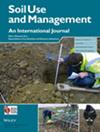Substitution of mineral N fertilizers with organic wastes in two long‐term field experiments: Dynamics and drivers of crop yields
IF 3.7
3区 农林科学
Q1 SOIL SCIENCE
引用次数: 0
Abstract
Organic wastes (OW) are rich in nutrients, and their recycling into agriculture can substitute chemical fertilizers. The level of substitution (partial with mineral fertilizer or exclusive with only OW), along with the method, amount, and timing of OW application, as well as the crop type, can impact crop productivity. The temporal dynamics of crop productivity after repeated applications of OW remain uncertain. Thus, two French long‐term field experiments (QualiAgro and PROspective, started in 1998 and 2000, respectively) were used to evaluate the effect of repeated OW applications on crop yield dynamics and investigate the potential driving factors affecting crop yields. Six different OW were applied: urban sewage sludge (SLU), green waste and SLU compost (GWS), biowaste compost (BIO), municipal solid waste compost (MSW), farmyard manure (FYM), and composted FYM (FYMC). The OW were applied every 2 years in QualiAgro (~4 t C ha在两个长期田间试验中用有机废物替代矿物氮肥:作物产量的动态和驱动因素
有机废物(OW)富含养分,将其回收利用到农业中可以替代化肥。替代程度(部分使用矿物肥料或仅使用有机废物)、施用有机废物的方法、数量和时间以及作物类型都会影响作物产量。反复施用 OW 后,作物生产力的时间动态仍不确定。因此,我们利用法国的两项长期田间试验(QualiAgro 和 PROspective,分别始于 1998 年和 2000 年)来评估重复施用 OW 对作物产量动态的影响,并研究影响作物产量的潜在驱动因素。共施用了六种不同的有机物:城市污水污泥(SLU)、绿色废物和 SLU 堆肥(GWS)、生物废物堆肥(BIO)、城市固体废弃物堆肥(MSW)、农家肥(FYM)和堆肥 FYM(FYMC)。在 QualiAgro(约 4 吨 C/公顷-1)和 PROspective(约 1.7 吨 C/公顷-1)中,每两年施用一次 OW。QualiAgro在高和低矿物氮条件下进行研究,而PROspective则在施用和未施用矿物氮肥的情况下进行研究。结果表明,在 QualiAgro 试验区,与矿物质氮对照相比,结合施用 OW 和高矿物质氮的玉米和小麦产量更高,而结合施用 OW 和低矿物质氮的玉米和小麦产量分别在施用 3 次和 6 次 OW 后达到与矿物质氮对照相同的水平。在 "前景 "研究地点,用 OW 部分替代矿物肥料可保持玉米产量,但会降低小麦产量,而与矿物氮对照相比,完全替代矿物肥料会导致玉米和小麦产量下降。梯度提升模型(GBM)的结果表明,玉米相对产量的主要驱动因素是土壤总氮,而不是矿物氮的投入,而在第二年,矿物氮肥的投入对小麦更为重要。我们的结论是,在保持高产和土壤肥力方面,联合使用有机肥和矿物肥要优于单独使用有机肥或矿物肥。我们进一步建议,要想用有机肥完全替代矿物肥,可能需要更频繁地施用有机肥,以满足作物的需求,和/或使用沼渣等氮利用率更高的有机肥。
本文章由计算机程序翻译,如有差异,请以英文原文为准。
求助全文
约1分钟内获得全文
求助全文
来源期刊

Soil Use and Management
农林科学-土壤科学
CiteScore
7.70
自引率
13.20%
发文量
78
审稿时长
3 months
期刊介绍:
Soil Use and Management publishes in soil science, earth and environmental science, agricultural science, and engineering fields. The submitted papers should consider the underlying mechanisms governing the natural and anthropogenic processes which affect soil systems, and should inform policy makers and/or practitioners on the sustainable use and management of soil resources. Interdisciplinary studies, e.g. linking soil with climate change, biodiversity, global health, and the UN’s sustainable development goals, with strong novelty, wide implications, and unexpected outcomes are welcomed.
 求助内容:
求助内容: 应助结果提醒方式:
应助结果提醒方式:


